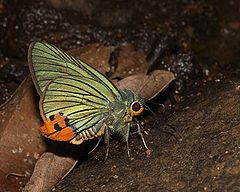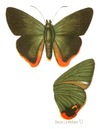- Choaspes benjaminii
-
Indian Awlking 
Scientific classification Kingdom: Animalia Phylum: Arthropoda Class: Insecta Order: Lepidoptera Family: Hesperiidae Genus: Choaspes Species: C. benjaminii Binomial name Choaspes benjaminii
(Guérin-Méneville, 1843) [1]Choaspes benjaminii,[2][3] commonly known as the Indian Awlking, is a butterfly belonging to the family Hesperiidae.
Contents
Range
The Indian Awlking is found in Sri Lanka, India, north Myanmar, Malaysia, Taiwan and Japan.[2]
In India, the Indian Awlking ranges from the Palni Hills, Nilgiris and Kodagu in the South to northern and eastern India; from Kulu to Assam and eastwards onto Myanmar.[4]
The type locality is Nilgiris, (South India).[2]
Status
Description
- For a key to the terms used see Lepidopteran glossary
The Indian Awlking is 50 to 60 mm long. It is distinguished by the shining green under hindwing with black veins, orange area with black spots on the tornus.
The male butterfly is shining indigo-blue above. It has purplish hairs at the base which turn greenish with age. Cilia of hindwing and anal lobe broadly ochreous-red.
The female butterfly is dark shining green with bluish-gray hairs at the base. forewing with a broad pale cupreous brown band on posterior margin ; hindwing with a broad ochreous-red lobular patch with black macular upper border and broad central angular streak.[6]
Thorax greyish olive above, vertex bluish olive, abdomen brown ; palpi and thorax in front and abdomen beneath, ochreous-red.[6]
Habits
The Indian Awlking is found in heavy jungles from 3500 feet to 8000 feet in the hills. It is attracted to flowers, animal and bird droppings. It frequents the shade in the daytime but is found flying in the open during the early and late hours of the day.[4]
Life cycle
Caterpillars
Larva with broad transverse dorsal black and yellow bands and two rows of white spots along the back ; head, two anal segments and laterally below the bands red ; face black spotted.[6]
Pupa
Pupa pinkish grey black spotted. The larva rolls itself upon the tip of the leaf on which it feeds, and when it has eaten this leaf it goes to another, and so on till it changes to pupa.[6]
Hostplants
The larva (caterpillar) has been recorded on Sabia campanulata, Meliosma pungens, Meliosma rhoifolia, Meliosma rigida, Meliosma squamulata,[2] and Buddleja.
Cited references
- ^ Card for Choaspes benjaminii in LepIndex. Accessed 12 October 2007.
- ^ a b c d Marrku Savela's Website on Lepidoptera - page on genus Choaspes.
- ^ TOL web page on genus Choaspes
- ^ a b c Wynter-Blyth, M.A. (1957) Butterflies of the Indian Region, pg 470.
- ^ Evans,W.H.(1932) The Identification of Indian Butterflies, ser no I 4.4, pg 321.
- ^ a b c d Watson, E. Y. (1891) Hesperiidae indicae. Vest and Co. Madras.
See also
- Coeliadinae
- Hesperiidae
- List of butterflies of India (Coeliadinae)
- List of butterflies of India (Hesperiidae)
References
Print
- Evans, W.H. (1932) The Identification of Indian Butterflies. 2nd Ed, (i to x, pp454, Plates I to XXXII), Bombay Natural History Society, Mumbai, India.
- Watson, E. Y. (1891) Hesperiidae indicae. Vest and Co. Madras.
- Wynter-Blyth, M.A. (1957) Butterflies of the Indian Region, Bombay Natural History Society, Mumbai, India.
Online
- Beccaloni, G. W., Scoble, M. J., Robinson, G. S. & Pitkin, B. (Editors). 2003. The Global Lepidoptera Names Index (LepIndex). World Wide Web electronic publication. [1] (accessed 22 September 2007).
- Brower, Andrew V. Z., (2007). Choaspes Moore 1881. Version 21 February 2007 (under construction). Page on genus Choaspes in The Tree of Life Web Project http://tolweb.org/.
- Savela, Marrku Website on Lepidoptera [2] (accessed 12 October 2007).
Categories:- Coeliadinae
- Butterflies of India
Wikimedia Foundation. 2010.

